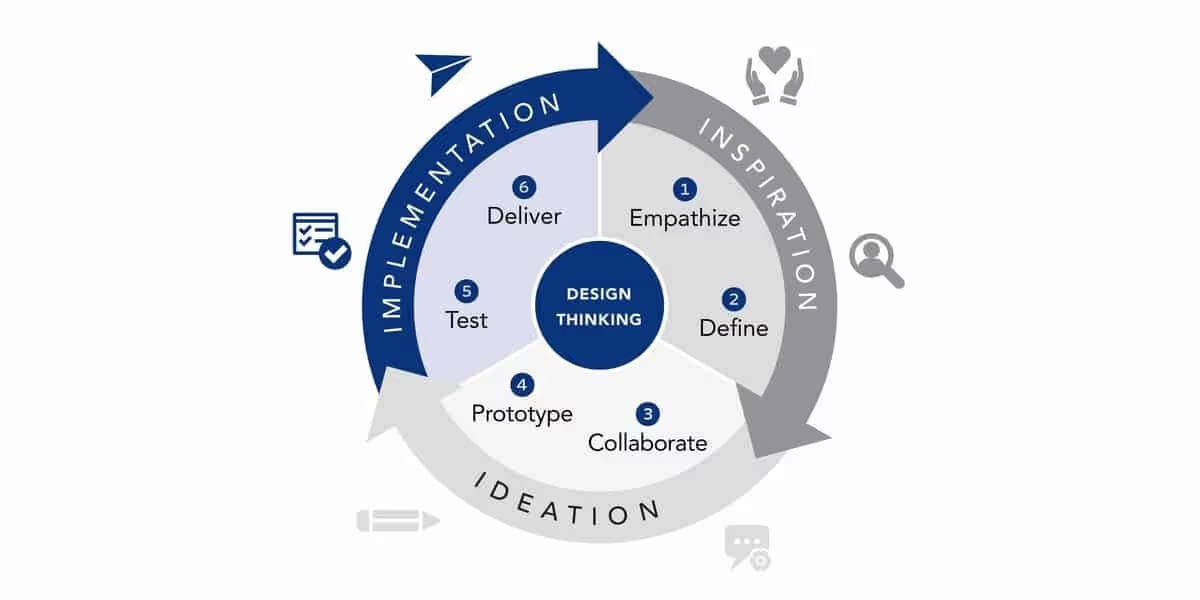Design thinking is a procedure composed of cognitive, strategic, and practical strategies implemented by designers. . This is why many team leaders around the world from various industries, not just graphic or digital design, began taking advantage of it. Learn how you can do it too!


Design thinking is a procedure composed of cognitive, strategic, and practical strategies implemented by designers. These procedures help professionals not only design better but also improve their teamwork and creativity skills. This is why many team leaders around the world from various industries, not just graphic or digital design, began taking advantage of it, as shown by its rise in popularity. In fact, 75% of organizations have recently self-reported that they are engaged in design thinking. This percentage is an exciting benchmark for what’s to come in the future of this procedure. Now, let’s talk about the benefits of design thinking for leaders!

A leader never stops learning, unless they’re happy with allowing their leadership skills to go to waste. That’s why team leaders benefit so much from design thinking techniques, as this procedure will help them gain critical leadership knowledge to implement with their teams. There are several leadership skills that can be accessed through design thinking the main ones are: increased empathy and optimism, creative problem solving, a better handle on ambiguity and uncertainty, a stronger capacity to seek new opportunities, vision prototyping, and product modeling. With these skills, you’ll be able to lead a more productive development team in no time!
The thing about design thinking is that it allows leaders to foster opportunities to connect with their teams in unique ways. From seeking new creative solutions to building a logical action plan to tackle a certain project, utilizing design thinking strategies boosts team collaboration and interaction. For example, a design thinking workshop led by a third-party professional can help you and your employees get to know each other in a more relaxed yet still professional environment. If you’re feeling a bit disconnected from your team or notice some friction between some of your team members, consider using a design thinking learning experience as a way to smooth any tensions.
Design thinking boosts collaboration and always enhances the importance of working as a team. There are no solo skills in design thinking, and this characteristic shows during every step of the method. Leaders trained in design thinking learn how to foster growth and have a team mentality that allows them to assign complex tasks to diverse groups of employees with unique sets of individual skills. Because design thinking is so focused on empathy, collaboration, and collective growth, these values will not only affect your projects and customer success rate. Instead, they will also transform your work environment for the better, helping team members to get along and work together on bewildering projects.
We've mentioned how design thinking fosters a collaborative work environment. Well, part of that is because this particular strategy helps team members align their skills toward a common goal. When ideating a project, design thinking mentalities emphasize the need to establish clear objectives from the beginning. Setting SMART goals through design thinking will help your employees understand what they’re working for and be on the same about what needs to be done and how it’s the best way to go about completing all tasks.
Another benefit of design thinking for leaders is its ability to quickly put the customer first. Design thinking takes proactive strategizing to the next level by constantly re-evaluating what customers want and need from a product or specific business. This is at the very core of the design thinking procedure, as the first step is to empathize with the potential customers and analyze their problems and possible solutions. Using these strategies will help you understand the end-user needs before actually designing the product, saving valuable time and resources in the process and mitigating the risk of software vulnerabilities.
The design thinking approach is heavily tied to Agile methodologies, fostering a unique advantage and one of the main benefits of design thinking for leaders of development teams. This is due to how both of these procedures force companies to react to what’s happening in the environment, swiftly adapt to any changes and even get ahead of the curve. Design thinking will provide you with an innovative toolbox for team leaders that allows you to ideate new products or strategies, develop them in collaboration with your team, and iterate development with client testing in order to deploy the best final results possible.
Now that you know the many advantages of design thinking for leaders, especially those in charge of Agile development teams, it’s time to reevaluate your project needs. Maybe your team is still missing a few members, or you need someone with a unique set of skills to get the ball rolling and take your design thinking strategies to the next level. The good news is that at Blue Coding we can help with both of these scenarios! In fact, we can even help you build a remote development team from scratch. Interested in hiring experienced developers for a fraction of the prize? Contact us today to learn how we can help you build your nearshore development team!
Subscribe to our blog and get the latest articles, insights, and industry updates delivered straight to your inbox